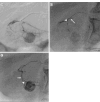Transarterial Chemoembolization for Hepatocellular Carcinoma: Current Role and Techniques
- PMID: 40384908
- PMCID: PMC12078018
- DOI: 10.22575/interventionalradiology.2024-0016
Transarterial Chemoembolization for Hepatocellular Carcinoma: Current Role and Techniques
Abstract
In the current systemic therapy era, such as immunotherapy and molecular targeted therapy, treatment strategy of hepatocellular carcinoma is changing. Transarterial chemoembolization is more expected as a curative treatment option than before. Therefore, it is important to learn key techniques of transarterial chemoembolization procedures to achieve complete response. This article delineates the current indications for transarterial chemoembolization and several techniques used for its implementation.
Keywords: combined therapy; hepatocellular carcinoma (HCC); transarterial chemoembolization (TACE).
© 2025 Japanese Society of Interventional Radiology.
Conflict of interest statement
T.T.: Honoraria and/or research funding are provided by Eisai, Stryker, Toray, and Canon Medical Systems.
Figures












Similar articles
-
Transarterial chemoembolization plus lenvatinib versus transarterial chemoembolization plus sorafenib as first-line treatment for hepatocellular carcinoma with portal vein tumor thrombus: A prospective randomized study.Cancer. 2021 Oct 15;127(20):3782-3793. doi: 10.1002/cncr.33677. Epub 2021 Jul 8. Cancer. 2021. PMID: 34237154 Clinical Trial.
-
Transarterial Chemoembolization (TACE) Combined with Lenvatinib versus TACE Alone in Intermediate-Stage Hepatocellular Carcinoma Patients Beyond Up-To-Seven Criteria: A Retrospective, Propensity Score-Matched Analysis.Acad Radiol. 2024 Nov;31(11):4456-4465. doi: 10.1016/j.acra.2024.04.045. Epub 2024 May 17. Acad Radiol. 2024. PMID: 38760273
-
Treatment Strategy for Intermediate-Stage Hepatocellular Carcinoma: Transarterial Chemoembolization, Systemic Therapy, and Conversion Therapy.Cancers (Basel). 2023 Mar 16;15(6):1798. doi: 10.3390/cancers15061798. Cancers (Basel). 2023. PMID: 36980684 Free PMC article. Review.
-
Comparison of the Treatment Response of Drug-Eluting Bead Transarterial Chemoembolization and Conventional Transarterial Chemoembolization in Patients With Hepatocellular Carcinoma.Cureus. 2023 Jul 11;15(7):e41701. doi: 10.7759/cureus.41701. eCollection 2023 Jul. Cureus. 2023. PMID: 37575777 Free PMC article.
-
Efficacy and features of balloon-occluded transarterial chemoembolization for hepatocellular carcinoma: a narrative review.Transl Gastroenterol Hepatol. 2024 Jun 20;9:48. doi: 10.21037/tgh-23-117. eCollection 2024. Transl Gastroenterol Hepatol. 2024. PMID: 39091662 Free PMC article. Review.
Cited by
-
Transarterial chemoembolization plus lenvatinib with or without protein-1 inhibitor for hepatocellular carcinoma with portal vein tumor thrombus.World J Clin Oncol. 2025 Jun 24;16(6):106798. doi: 10.5306/wjco.v16.i6.106798. World J Clin Oncol. 2025. PMID: 40585829 Free PMC article.
References
-
- Park C, Chu HH, Kim JH, et al. Clinical significance of the initial and best responses after chemoembolization in the treatment of intermediate-stage hepatocellular carcinoma with preserved liver function. J Vasc Interv Radiol. 2020; 31: 1998-2006.e1. - PubMed
-
- Horikawa M, Miyayama S, Irie T, Kaji T, Arai Y. Development of conventional transarterial chemoembolization for hepatocellular carcinomas in Japan: historical, strategic, and technical review. AJR Am J Roentgenol. 2015; 205: 764-773. - PubMed
-
- Ikeda M, Arai Y, Park SJ, et al. Prospective study of transcatheter arterial chemoembolization for unresectable hepatocellular carcinoma: an Asian cooperative study between Japan and Korea. J Vasc Interv Radiol. 2013; 24: 490-500. - PubMed
Publication types
LinkOut - more resources
Full Text Sources
Miscellaneous

